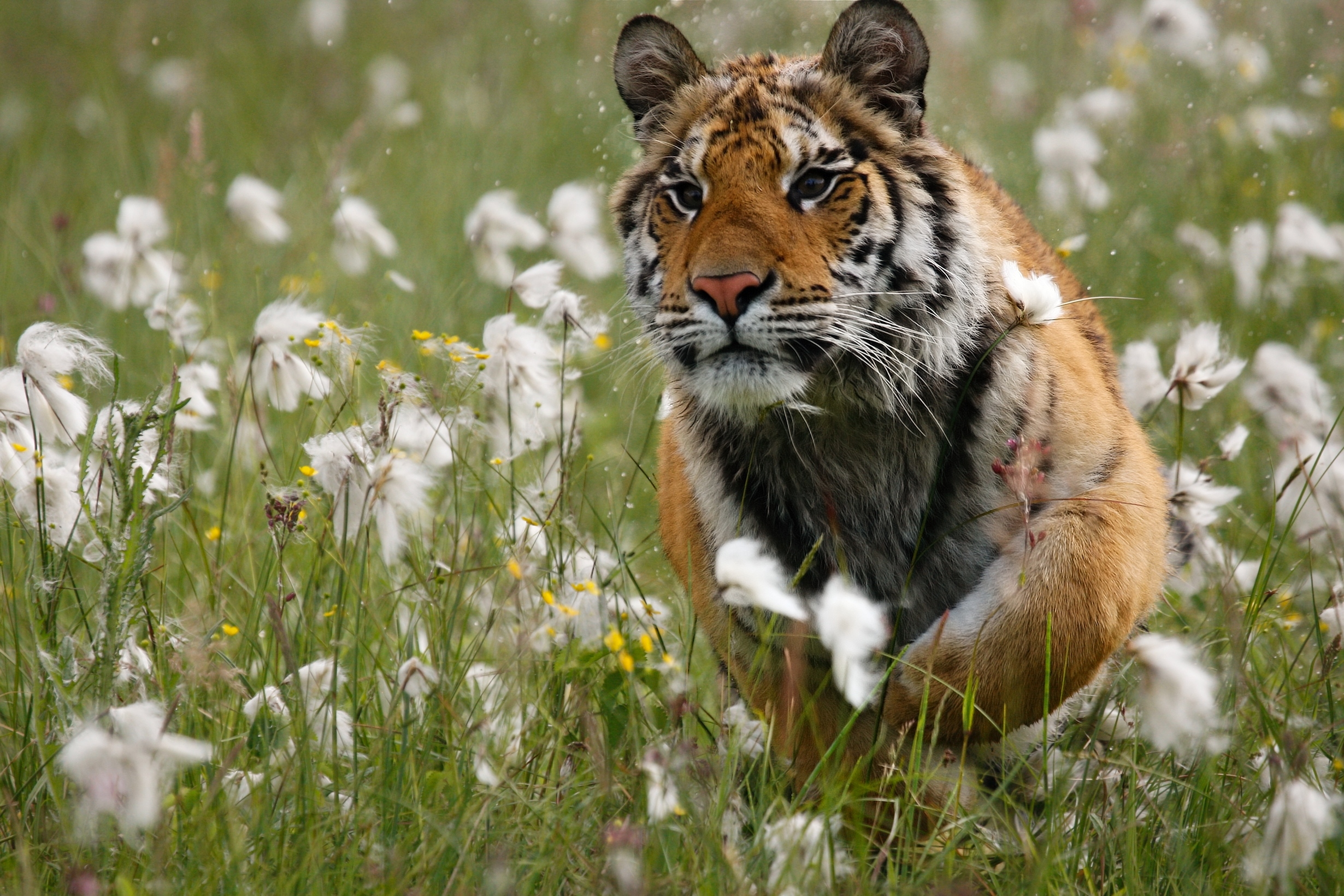Tigers are one of the most interesting of the big cats.
We're seeing a lot of talk about tigers in the news right now thanks to the hit Netflix documentary series "Tiger King" about the captive breeding of these big cats. We won't dig into that show, or its colorful characters and weird conspiracies here.
We have noticed that people have plenty of burning questions about this cat species and today we will attempt to answer them.
These tiger facts are meant to answer some of the Internet's most burning questions about these beautiful and solitary animals.
How much does a tiger weigh?

Until you see one of these giant carnivores standing next to a human, it's difficult to fathom just how large they can grow. This is one of the largest cats in the world. The size does vary depending on the subspecies of tiger. Some naturally grow larger than others, but all adult tigers are bigger than you probably realize.
We'll start off with the Bengal tiger since that is the one most people know best. The average Bengal stands between 30 and 40 inches tall. For comparison, a German shepherd dog is only about 26 inches!
The weight of these animals is even more shocking. At least one Bengal shot by a hunter weighed over 850 pounds and several others have been recorded in the 600 to 700-pound range. However, the average weight of an adult male tends to fall in the range of 400 to 500 pounds. Female tigers are usually smaller but are still huge. Their average weight tends to hover around 210-350 pounds!
The Siberian tiger is another tiger subspecies that gets mentioned often, it's often also called the "Amur tiger" by some people. This animal doesn't get quite as large as the Bengal, but it is still huge. This animal can reach upwards of 600 pounds for males and 360 pounds for females. Ones in captivity are usually larger. The average size of wild cats tends to hover at around 300 pounds for females and 470 pounds for a male Siberian tiger.
The Indochinese tiger can reach 330-430 pounds of peak weight for males and 290 pounds for females. A slightly smaller species is the South China tiger. This animal tends to top out at around 280-380 pounds for males and 220-250 pounds for females. Malayan tigers rarely grow heavier than around 220 pounds. Another tiger species, the Sumatran tiger, has an average weight of ONLY around 160-240 pounds for females and 220 to 300 pounds for males.
As you can see, the weight varies quite a bit. There is a reason they are the biggest cats in the world. To put things into better perspective, consider North America's largest member of the cat family, the mountain lion. The average lion or cougar, as they are also known, rarely gets over 100 pounds!
Where do tigers live?
Unfortunately, the home ranges of these big cats have shrunk significantly over the last 200 years due to over-hunting, poaching and loss of vital tiger habitat. Today, tigers are concentrated mostly in India and parts of Asia. They around found throughout southern Nepal and throughout Bhutan. Their range just barely skirts the edges of the Himalayas and the southern part of Bangladesh.
Tiger populations used to be common throughout Vietnam, Cambodia and Myanmar, but are believed to be mostly extinct in those areas according to the International Union for Conservation of Nature. Some populations are still scattered through parts of Laos and Thailand.
South of there, the animals still have extensive home ranges through much of Malaysia and Sumatra. Siberian tigers make up a more northerly population in Eastern Russia and China. Current ranges in Northeast China come very close to the North Korea border. Some have speculated there may still be some living there, but because of the country's secretive and isolated nature, it's unlikely scientists will know anytime soon.
What do tigers eat?

Like many other big cats, the natural prey for wild tigers is usually the native ungulates in their area. Most of the tiger's home range is also home to a variety of cervid deer species, antelope, buffalo and wild boars that make up the primary parts of their diet.
Tigers are opportunistic predators and they're often not that picky about what they'll eat. They've also been known to snack on snakes, bears and even crocodiles on occasion. Unfortunately, this opportunistic nature is also what brings them into conflict with humans when they start snatching cows, pigs, chickens and other livestock from humans. That brings us to our next question.
Do tigers attack humans?

Wikimedia Commons:Author Unknown
It is true that there have been some horrific tiger attacks on humans in history. One of the more notorious ones was the Champawat tiger which is pictured above. That animal is believed to have killed over 400 people in the late 1800s and early 1900s. However, when the animal was shot by professional hunter Jim Corbett, he noted the animal had significant damage to its teeth.
This damage likely made it more difficult for the tiger to take down her natural prey, so she switched to something that was easier to catch. Over the course of his hunting career, Corbett recorded that most tigers who took to attacking humans did so for similar reasons. For instance, the Thak man-eater was a female tiger that was suffering the effects of two old gunshot wounds. It was a similar story for one of the tigers of Chowgarh. These attacks by an adult female and her cub killed 64 people in the early 1920s in India. After he shot them, Corbett found the mother tiger showed worn teeth and broken claws.
Scientists generally believe tigers are not naturally man-eaters. Usually there is some set of extenuating circumstances that leads to this sort of thing. Sometimes it is just simple conflict between humans and tigers as the animals lose their habitat. Other man-eaters are believed to have changed their diets while scavenging the bodies of humans killed during wars.
Unfortunately, the fact that tigers are so capable of killing humans has led to much fear of these animals. It's also likely what has led to their decreased numbers today.
How long do tigers live?
As is the case with most animals, tigers live to a much older age when in captivity. Tigers reaching 20 years old isn't uncommon for zoos or big cat rescue centers. In the wild, they generally don't live much more than 15 years at the most. They can spend up to two years with their mother before they are on their own.
Most tigers don't reach sexual maturity until three to five years old. Combine that with a high infant mortality rate and the fact that female tigers usually only give birth every couple of years and it's easy to see why tiger numbers have struggled to rebound as their numbers have dwindled.
Why are tigers endangered?

If you watched "Tiger King," you likely were astounded when they proclaimed there are more tigers in captivity than there are in the wild. Unfortunately, it's true. The IUCN lists the estimate of mature animals on their website at 2,154 to 3,159 in the wild as of this writing. That number doesn't include tiger cubs, but that is still a distressing number to hear. The animals are officially classified as "endangered" by the organization and their projections show the population is continuing to drop.
So, what are the primary threats? Humans, humans and more humans unfortunately. As people have encroached on the wild areas these animals live, tigers are suffering extreme habitat loss to urban development, agriculture, mining and more.
As if the habitat loss wasn't enough, there are also problems with poaching. There is a huge black market for tiger body parts where they are used for dubiously believable medicinal purposes. Still other tigers are killed by poachers for their hides and parts to be used for decorative or clothing purposes. Many countries have stepped up conservation efforts to make much harsher penalties for tiger poaching and the trade of tiger parts. However much more work still needs to be done to help the tigers turn the corner, including the possibility of re-introducing animals back into their native ranges.
Hopefully, the recent success of "Tiger King" will help educate more people on the plight of these animals and will lead to greater conservation movements to preserve these animals in the wild!
For more outdoor content from Travis Smola, be sure to follow him on Twitter and check out his Geocaching and Outdoors with Travis YouTube channels.
NEXT: HOW BIG IS A MOOSE REALLY?
WATCH




